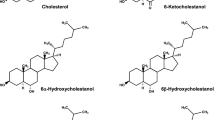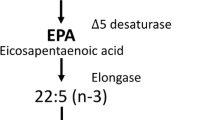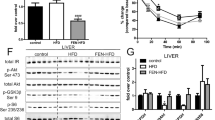Abstract
Cholesterol oxidation products (oxycholesterols) are produced from cholesterol by automatic and/or enzymatic oxidation of the steroidal backbone and side-chain. Oxycholesterols are present in plasma and serum, suggesting that oxycholesterols are related to the development and progression of various diseases. However, limited information is available about the absolute amounts of oxycholesterols in organs and tissues, and the physiological significance of oxycholesterols in the body. In the present study, we quantified the levels of 13 oxycholesterols in white adipose tissue (WAT) of mice and then evaluated correlations between each oxycholesterol level and WAT weight. The sum of the levels of 13 oxycholesterols in WAT (white adipose tissue) was 15.9 ± 3.4 μg/g of WAT weight and approximately 1 % of cholesterol level. Among oxycholesterols, the levels of 27-hydroxycholesterol (27-OH), an endogenous oxycholesterol produced by enzymatic oxidation, and the relative WAT weights were significantly negatively correlated. Next, we evaluated the effects of 27-OH on lipogenesis and adipogenesis in 3T3-L1 cells. TO901317 (TO), a potent and selective agonist for LXRα, significantly increased intracellular TAG contents, while 27-OH significantly reduced the contents to half when compared with control (DMSO) and completely abolished the effect of TO. In addition, 27-OH significantly reduced the mRNA levels of lipogenic (LXRα and FAS) and adipogenic genes (PPARγ and aP2) during adipocyte maturation of 3T3-L1 cells. In conclusion, our results indicate that 27-OH suppresses lipid accumulation by down-regulating lipogenic and adipogenic gene expression in 3T3-L1 cells.




Similar content being viewed by others
References
American Institute of Nutrition (1977) Report of the American Institute of Nurtition ad hoc Committee on Standards for Nutritional Studies. J Nutr 107:1340–1348
Ando M, Tomoyori H, Imaizumi K (2002) Dietary cholesterol-oxidation products accumulate in serum and liver in apolipoprotein E-deficient mice, but do not accelerate atherosclerosis. Br J Nutr 88:339–345
Bikle D (2001) Vitamin D regulation of immune function. In: Litwack G (ed) Vitamins and the immune system, vol 86. Elsevier, Amsterdam, pp 1–21
Björkhem I, Diczfalusy U (2002) Oxysterols: friends, foes, or just fellow passengers? Arterioscler Thromb Vasc Biol 22:734–742
Chirgwin JM, Przbyla AE, McDonald RJ, Rutter WJ (1979) Isolation of biologically active ribonucleic acid from sources enriched in ribonuclease. Biochemistry 18:5294–5299
Granlund L, Pedersen JI, Nebb HI (2005) Impaired lipid accumulation by trans10, cis12 CLA during adipocyte differentiation is dependent on timing and length of treatment. Biochim Biophys Acta 1687:11–22
Janowski BA, Willy PJ, Devi TR, Falck JR, Mangelsdorf DJ (1996) An oxysterol signalling pathway mediated by the nuclear receptor LXR alpha. Nature 383:728–731
Joseph SB, Laffitte BA, Patel PH, Watson MA, Matsukuma KE, Walczak R, Collins JL, Osborne TF, Tontonoz P (2002) Direct and indirect mechanisms for regulation of fatty acid synthase gene expression by liver X receptors. J Biol Chem 277:11019–11025
Juvet LK, Andresen SM, Schuster GU, Dalen KT, Tobin KA, Hollung K, Haugen F, Jacinto S, Ulven SM, Bamberg K, Gustafsson JA, Nebb HI (2003) On the role of liver X receptors in lipid accumulation in adipocytes. Mol Endocrinol 17:172–182
Kim JB, Spiegelman BM (1996) ADD1/SREBP1 promotes adipocyte differentiation and gene expression linked to fatty acid metabolism. Genes Dev 10:1096–1107
Laurencikiene J, Rydén M (2012) Liver X receptors and fat cell metabolism. Int J Obes (Lond) 36:1494–1502
Lee J, Lee J, Jung E, Kim YS, Roh K, Jung KH, Park D (2010) Ultraviolet A regulates adipogenic differentiation of human adipose tissue-derived mesenchymal stem cells via up-regulation of Kruppel-like factor 2. J Biol Chem 285:32647–32656
Lefterova MI, Zhang Y, Steger DJ, Schupp M, Schug J, Cristancho A, Feng D, Zhuo D, Stoeckert CJ Jr, Liu XS, Lazar MA (2008) PPARgamma and C/EBP factors orchestrate adipocyte biology via adjacent binding on a genome-wide scale. Genes Dev 22:2941–2952
Li J, Daly E, Campioli E, Wabitsch M, Papadopoulos V (2014) De novo synthesis of steroids and oxysterols in adipocytes. J Biol Chem 289:747–764
Lowry OH, Rosebrough NJ, Farr AL, Randall RJ (1951) Protein measurement with the Folin phenol reagent. J Biol Chem 193:265–275
Matsuoka R, Shirouchi B, Kawamura S, Baba S, Shiratake S, Nagata K, Imaizumi K, Sato M (2014) Dietary egg white protein inhibits lymphatic lipid transport in thoracic lymph duct-cannulated rats. J Agric Food Chem 62:10694–10700
Matsuzawa Y (2006) Therapy Insight: adipocytokines in metabolic syndrome and related cardiovascular disease. Nat Clin Pract Cardiovasc Med 3:35–42
Schroepfer GJ Jr (2000) Oxysterols: modulators of cholesterol metabolism and other processes. Physiol Rev 80:361–554
Schultz JR, Tu H, Luk A, Repa JJ, Medina JC, Li L, Schwendner S, Wang S, Thoolen M, Mangelsdorf DJ, Lustig KD, Shan B (2000) Role of LXRs in control of lipogenesis. Genes Dev 14:2831–2838
Sottero B, Gamba P, Gargiulo S, Leonarduzzi G, Poli G (2009) Cholesterol oxidation products and disease: an emerging topic of interest in medicinal chemistry. Curr Med Chem 16:685–705
Willy PJ, Umesono K, Ong ES, Evans RM, Heyman RA, Mangelsdorf DJ (1995) LXR, a nuclear receptor that defines a distinct retinoid response pathway. Genes Dev 9:1033–1045
Yanai H (2011) Statcel 3—the usefull add-in software forms on Excel, 3rd edn. OMS, Tokyo
Acknowledgments
This work was supported by JSPS KAKENHI Grant Numbers 21580144, 23780138.
Authors’ contributions
B.S. wrote the manuscript. B.S., K.K., Y.H., Y.N., Y.F. and LT.T. participated in the experimental work and collected and analyzed data. B.S. and M.S. contributed to the study design, supervised the study, and commented on the manuscript. All authors have read and approved the final version of the manuscript.
Author information
Authors and Affiliations
Corresponding author
Ethics declarations
Conflict of interest
None.
Rights and permissions
About this article
Cite this article
Shirouchi, B., Kashima, K., Horiuchi, Y. et al. 27-Hydroxycholesterol suppresses lipid accumulation by down-regulating lipogenic and adipogenic gene expression in 3T3-L1 cells. Cytotechnology 69, 485–492 (2017). https://doi.org/10.1007/s10616-016-9962-5
Received:
Accepted:
Published:
Issue Date:
DOI: https://doi.org/10.1007/s10616-016-9962-5




